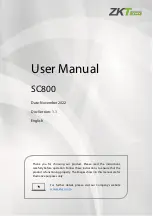
5
o
peration
5-12
Setting the "Speed", "Accel.", and "Decel." data
n
1.When using the "Standard setting" point type
The "Speed" and "Accel." settings are specified as a percentage of the optimal positioning speed and acceleration
values for each robot type, based on that robot's maximum speed and maximum payload acceleration values. The
"Decel." is specified as a percentage of the "Accel." setting.
Point type: Standard setting
Speed
Time
Speed
Acceleration
Deceleration
"Speed" setting range: 1 to 100 [%]
When 100%, the max. speed is
1200.00 [mm/s].
Max. speed = 1200.00 [mm/s]
Max. acceleration = 8.00 [m/s
2
]
Max. payload acceleration = 4.00 [m/s
2
]
"Acceleration setting range: 1 to 100 [%]
When 100%, the max. payload accel.
is 4.00 [m/s
2
].
"Deceleration" setting range: 1 to 100 [%]
Set as a percentage of the
acceleration value.
23508-M0-00
2.When using the "Custom setting" point type
The "Speed" and "Accel." settings are specified by adopting the maximum speed and acceleration (max. payload
acceleration with 0kg payload) values for each robot type as the maximum setting values. If the specified acceleration
value exceeds the max. payload acceleration defined by the payload setting, the max. payload acceleration value is
used as the setting value.
Point type: Custom setting
Speed
Time
Speed
Acceleration
Deceleration
"Speed" setting range: 0.01 to 1200.00 [mm/s]
The max. setting value is the max.
speed of each robot type.
Max. speed = 1200.00 [mm/s]
Max. acceleration = 8.00 [m/s
2
]
Max. payload acceleration = 4.00 [m/s
2
]
"Acceleration setting range: 0.01 to 8.00 [m/s
2
]
The max. input value is the max.
speed of each robot type.
The max. acceleration is the max.
payload acceleration.
"Deceleration" setting range: 1 to 100 [%]
Set as a percentage of the
acceleration value.
23509-M0-00
c
CAutIoN
Select "Standard setting" or "Custom setting" in the initial processing performed by the tS-Manager support
software (optional).
Speed command error during custom setting
n
The setting speed error can be calculated according to the relationship between the resolution and lead length per motor
rotation.
Example: When the resolution is 16384 (pulses/rotation) and the lead length (movement amount per rotation) is 20.00
mm, the number of pulses per 1 mm is 819.2 (16384÷20).
When the speed is set to 0.01 mm/s, 8.192 (819.2 x 0.01) is obtained. The fractional portion (0.192 pps) of this
number is truncated (8.192
⇒
8 pps).
So, an error of 2.4% (8.192 - 8.000)/8.000) may occur.
c
CAutIoN
this calculated error value is a logical value (reference). Actually, this value may vary depending on the
conditions, such as friction.
















































